Pony Express
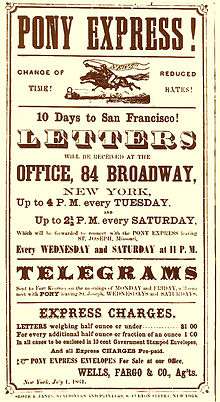
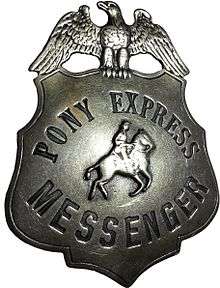
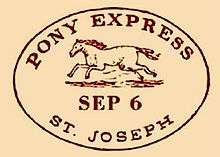
The Pony Express was a mail service delivering messages, newspapers, and mail.
Officially operating as the Leavenworth and Pike's Peak Express Company of 1859, in 1860 it became the Central Overland California and Pikes Peak Express Company; this firm was founded by William H. Russell, Alexander Majors, and William B. Waddell, all of whom were notable in the freighting business.[1]
During its 19 months of operation, it reduced the time for messages to travel between the Atlantic and Pacific coasts to about 10 days.[2] From April 3, 1860 to October 1861, it became the West's most direct means of east–west communication before the telegraph was established and was vital for tying the new state of California with the rest of the United States.
Inception and founding

The idea of a fast mail route to the Pacific coast was prompted largely by California's newfound prominence and its rapidly growing population. After gold was discovered there in 1848, thousands of prospectors, investors and businessmen made their way to California, at that time a new territory of the U.S. By 1850, California entered the Union as a free state. By 1860, the population had grown to 380,000.[3] The demand for a faster way to get mail and other communications to and from this westernmost state became even greater as the American Civil War approached.
In the late 1850s, William Russell, Alexander Majors, and William Waddell were the three founders of the Pony Express. They were already in the freighting and drayage business. At the peak of the operations, they employed 6,000 men, owned 75,000 oxen, thousands of wagons and warehouses plus a sawmill, a meatpacking plant, a bank and an insurance company.[4]
Russell was a prominent businessman, well respected among his peers and the community. Waddell was co-owner of the firm Morehead, Waddell & Co. After Morehead was bought out and retired, Waddell merged his company with Russell's, changing the name to Waddell & Russell. In 1855 they took on a new partner, Alexander Majors, and founded the company of Russell, Majors & Waddell.[5] They held government contracts for delivering army supplies to the western frontier, and Russell had a similar idea for contracts with the U.S. Government for fast mail delivery.[6]
By utilizing a short route and using mounted riders rather than traditional stagecoaches, they proposed to establish a fast mail service between St. Joseph, Missouri, and Sacramento, California, with letters delivered in 10 days, a duration many said was impossible. The initial price was set at $5 per 1⁄2 ounce (14 g), then $2.50, and by July 1861 to $1. The founders of the Pony Express hoped to win an exclusive government mail contract, but that did not come about.
Russell, Majors, and Waddell organized and put together the Pony Express in two months in the winter of 1860. The undertaking assembled 120 riders, 184 stations, 400 horses, and several hundred personnel during January and February 1861.[7]
Alexander Majors was a religious man and resolved "by the help of God" to overcome all difficulties. He presented each rider with a special edition Bible and required this oath,[8][9] which they were also required to sign.[10]
"I, ..., do hereby swear, before the Great and Living God, that during my engagement, and while I am an employee of Russell, Majors, and Waddell, I will, under no circumstances, use profane language, that I will drink no intoxicating liquors, that I will not quarrel or fight with any other employee of the firm, and that in every respect I will conduct myself honestly, be faithful to my duties, and so direct all my acts as to win the confidence of my employers, so help me God."
The Pony Express demonstrated that a unified transcontinental system of communications could be established and operated year round. When replaced by the telegraph, the Pony Express quickly became romanticized and became part of the lore of the American West. Its reliance on the ability and endurance of individual young, hardy riders and fast horses was seen as evidence of rugged American individualism of the Frontier times.
From 1866 until 1889, the Pony Express logo was used by stagecoach and freight company Wells Fargo, which provided secure mail service. The United States Postal Service (USPS) used "Pony Express" as a trademark for postal services in the US.[13] Freight Link international courier services, based in Russia, adopted the Pony Express trademark and a logo similar to that of the USPS.[14]
Operation

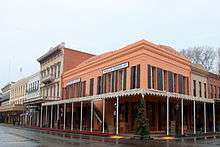
In 1860, there were about 157 Pony Express stations that were about 10 miles (16 km) apart along the Pony Express route.[7] At each station stop the express rider would change to a fresh horse, taking only the mail pouch called a mochila (from the Spanish for pouch or backpack) with him.
The employers stressed the importance of the pouch. They often said that, if it came to be, the horse and rider should perish before the mochila did. The mochila was thrown over the saddle and held in place by the weight of the rider sitting on it. Each corner had a cantina, or pocket. Bundles of mail were placed in these cantinas, which were padlocked for safety. The mochila could hold 20 pounds (9 kg) of mail along with the 20 pounds (9 kg) of material carried on the horse.[16] Eventually, everything except one revolver and a water sack was removed, allowing for a total of 165 pounds (75 kg) on the horse's back. Riders, who could not weigh over 125 pounds (57 kg), changed about every 75–100 miles (120–160 km), and rode day and night. In emergencies, a given rider might ride two stages back to back, over 20 hours on a quickly moving horse.
It is unknown if riders tried crossing the Sierra Nevada in winter, but they certainly crossed central Nevada. By 1860 there was a telegraph station in Carson City, Nevada. The riders received $100 a month as pay. A comparable wage for unskilled labor at the time was about $0.43–$1 per day.
Alexander Majors, one of the founders of the Pony Express, had acquired more than 400 horses for the project. He selected horses from around the west, paying an average of $200.[17] These averaged about 14 1⁄2 hands (4 feet 10 inches or 1.47 meters) high and averaged 900 pounds (410 kg)[18] each; thus, the name pony was appropriate, even if not strictly correct in all cases.
Pony Express route
The approximately 1,900-mile-long (3,100 km) route[19] roughly followed the Oregon and California Trails to Fort Bridger in Wyoming, and then the Mormon Trail (known as the Hastings Cutoff) to Salt Lake City, Utah. From there it followed the Central Nevada Route to Carson City, Nevada before passing over the Sierra into Sacramento, California.[20]

by William Henry Jackson
~ Courtesy the Library of Congress ~
The Pony Express mail route, April 3, 1860 – October 24, 1861; Reproduction of Jackson illustration issued to commemorate the 100th anniversary of Pony Express founding on April 3, 1960. Reproduction of Jackson's map issued by the Union Pacific Railroad Company.
The route started at St. Joseph, Missouri on the Missouri River, it then followed what is modern-day U.S. Highway 36 (US 36 the Pony Express Highway) to Marysville, Kansas, where it turned northwest following Little Blue River to Fort Kearny in Nebraska. Through Nebraska it followed the Great Platte River Road, cutting through Gothenburg, Nebraska, clipping the edge of Colorado at Julesburg, Colorado, and passing Courthouse Rock, Chimney Rock, and Scotts Bluff, before arriving at Fort Laramie in Wyoming. From there it followed the Sweetwater River, passing Independence Rock, Devil's Gate, and Split Rock, to Fort Caspar, through South Pass to Fort Bridger and then down to Salt Lake City. From Salt Lake City it generally followed the Central Nevada Route blazed by Captain James H. Simpson of the Corps of Topographical Engineers in 1859. This route roughly follows today's US 50 across Nevada and Utah. It crossed the Great Basin, the Utah-Nevada Desert, and the Sierra Nevada near Lake Tahoe before arriving in Sacramento. Mail was then sent via steamer down the Sacramento River to San Francisco. On a few instances when the steamer was missed, riders took the mail via horseback to Oakland, California.
Stations
There were 184 stations along the long and arduous route used by the Pony Express. The stations and station keepers were essential to the successful, timely and smooth operation of the Pony Express mail system. The stations were often fashioned out of existing structures, several of them located in military forts, while others were built anew in remote areas where living conditions were very basic.[21] The route was divided up into five divisions.[22] To maintain the rigid schedule, 157 relay stations were located from 5 to 25 miles (8 to 40 km) apart as the terrain would allow for. At each swing station, riders would exchange their tired mounts for fresh ones, while "home stations" provided room and board for the riders between runs. This technique allowed the mail to be whisked across the continent in record time. Each rider rode about 75 miles (120 km) per day.[23]
Division One: Stations between St. Joseph and Fort Kearney Missouri: Kansas: Nebraska:
Nebraska (continued): Pony Express Marker along the South Platte River in western Nebraska on US 30 (Lincoln Hwy) 40. Diamond Springs Station Colorado: Nebraska (continued): Wyoming:
Wyoming (continued) : Utah:
Utah (continued): Nevada:
Nevada (continued):
136. Camp Station, Grub(b)s Well Station California: |
First journeys
Westbound
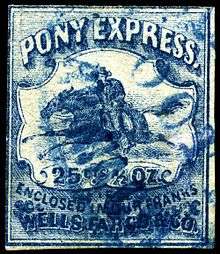
The first Westbound Pony Express trip left St. Joseph on April 3, 1860 and arrived ten days later in San Francisco, California, on April 14. These letters were sent under cover from the East to St. Joseph, and never directly entered the U.S. mail system. Today there is only a single letter known to exist from the inaugural westbound trip from St. Joseph, Missouri to San Francisco, California.[24] The mailing depicted below is on a pre-stamped (embossed) envelope, first issued by the U.S. Post Office in 1855, used five years later here.[25]
The messenger delivering the mochila from New York and Washington, DC, missed a connection in Detroit and arrived in Hannibal, Missouri, two hours late. The railroad cleared the track and dispatched a special locomotive called Missouri with a one-car train to make the 206-mile (332 km) trek across the state in a record 4 hours 51 minutes, an average of 40 miles per hour (64 km/h).[26] It arrived at Olive and 8th Street, a few blocks from the company's new headquarters in a hotel at Patee House at 12th and Penn Street and the company's nearby stables on Penn Street. The first pouch contained 49 letters, five private telegrams, and some papers for San Francisco and intermediate points.[27]
St. Joseph Mayor M. Jeff Thompson, William H. Russell, and Alexander Majors gave speeches before the mochila was handed off. The ride began at about 7:15 p.m. The St. Joseph Gazette was the only newspaper included in the bag.
The identity of the first rider has long been in dispute. The St. Joseph Weekly West (April 4, 1860) reported Johnson William Richardson was the first rider.[28] Johnny Fry is credited in some sources as the rider. Nonetheless, the first westbound rider carried the pouch across the Missouri River ferry to Elwood, Kansas. The first horse-ridden leg of the Express was only about 1⁄2 mile (800 m) from the Express stables/railroad area to the Missouri River ferry at the foot of Jules Street. Reports indicated that horse and rider crossed the river. In later rides, the courier crossed the river without a horse and picked up his mount at a stable on the other side.
The first westbound mochila reached its destination, San Francisco, on April 14, at 1:00 a.m.[29]
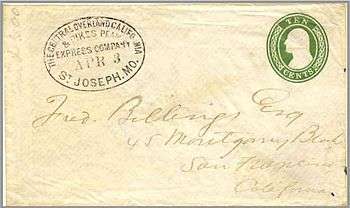
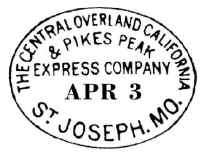
Eastbound
The first eastbound Pony Express trip left San Francisco, California, on April 3, 1860 and arrived at its destination ten days later in St. Joseph, Missouri. From St. Joseph, letters were placed in the U.S. mails for delivery to eastern destinations. There are only two letters known to exist from the inaugural eastbound trip from San Francisco to St. Joseph.[30]
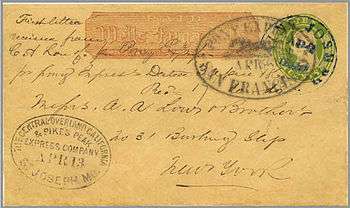
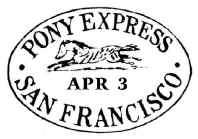
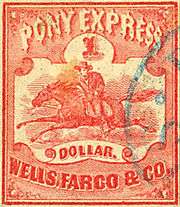
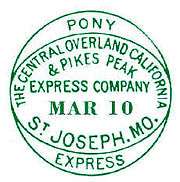
As the Pony Express Mail service existed only briefly in 1860 and 1861 there are consequently very few surviving examples of Pony Express mail. Also, contributing to the scarcity of surviving Pony Express mail is that the cost to send a 1⁄2-ounce (14 g) letter was $5.00[31] at the beginning, (about $130.00 to today's standards). By the end period of the Pony Express, the price had dropped to $1.00 per 1⁄2 ounce but even that was considered expensive (equivalent to $26 in 2015[32]) just to mail one letter. As this mail service was also a frontier enterprise, removed from the general population in the east, along with the largely unaffordable rates, there are consequently few pieces of surviving Pony Express mail in the hands of collectors and museums. There are only 250 known examples of Pony Express mail.[24]
Postmarks
Various postmarks were added to mail to be carried by the Pony Express at the point of departure.
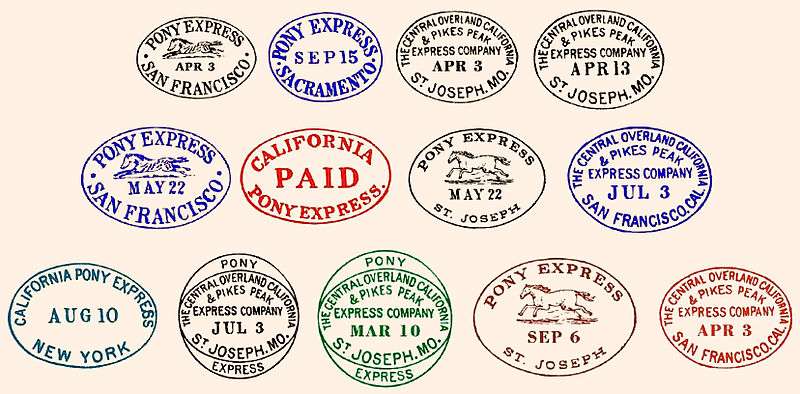
Fastest mail service
William Russell, senior partner of 'Russell, Majors, and Waddell' and one of the biggest investors in the Pony Express, used the 1860 presidential election as a way to promote the Pony Express and how fast it could deliver the U.S. Mail. Prior to the election, Russell hired extra riders to ensure that fresh riders and relay horses were available along the route. On November 7, 1860, a Pony Express rider departed Fort Kearny, Nebraska Territory (the end of the eastern telegraph line) with the election results. Riders sped along the route, over snow-covered trails and into Fort Churchill, Nevada Territory (the end of the western telegraph line). California's newspapers received word of Lincoln's election only seven days and 17 hours after the East Coast papers, an unrivaled feat at the time.[34]
Attacks

The Paiute War was a minor series of raids and ambushes initiated by the Paiute Indian tribe in Nevada, which resulted in the disruption of mail services of the Pony Express. It took place from May through June 1860, though sporadic violence continued for a period afterward. In the brief history that the Pony Express operated only once did the mail not go through. After completing eight weekly trips from both Sacramento and Saint Joseph, the Pony Express was forced to suspend mail services because of the outbreak of the Paiute Indian War in May 1860.
Approximately 6,000 Paiutes in Nevada had suffered during a winter of fierce blizzards that year. By spring, the whole tribe was ready to embark on a war, except for the Paiute chief named Numaga. For three days Numaga fasted and argued for peace.[36] Meanwhile, a raiding party attacked Williams Station, a Pony Express station located on the Carson River near present-day Lake Lahontan. One account says the raid was a deliberate attempt to provoke war. Another says the raiders had heard that men at the station had kidnapped two Paiute women, and fighting broke out when they went to investigate and free the women. Either way, the war party killed five men and the station was burned.[37]
During the following weeks, other isolated incidents occurred when whites in Paiute country were ambushed and killed. The Pony Express was a special target. Seven other express stations were also attacked; some 16 employees were killed and approximately 150 express horses were either stolen or driven off. The Paiute war cost the Pony Express company about $75,000 in livestock and station equipment, not to mention the loss of life. In June of that year, the Paiute uprising had been ended through the intervention of U.S. government troops, after which four delayed mail shipments from the East were finally brought to San Francisco on June 25, 1860.[38]
During this brief war, one Pony Express mailing, which left San Francisco on July 21, 1860, did not immediately reach its destination. That mail pouch (mochila) did not reach St. Joseph and subsequently New York until almost two years later.
Famous riders
In 1860, riding for the Pony Express was difficult work — riders had to be tough and lightweight. A famous advertisement allegedly read:
The Pony Express had an estimated 80 riders who were traveling east or west along various points of the route at any given time. In addition, there were also about 400 other employees, including station keepers, stock tenders and route superintendents. Many young men applied for jobs with the Pony Express, all eager to face the dangers and the challenges that sometimes lay along the delivery route. Waddell and Majors could have easily hired them at a much lesser rate, but instead paid them a handsome sum for that time of one hundred dollars a month.[40] Famous American author Mark Twain, who saw the Pony Express in action first hand, described the riders in his travel memoir Roughing It as: "... usually a little bit of a man". Though the riders were small, lightweight, generally teenage boys, their untarnished record proved them to be heroes of the American West for the much needed and dangerous service they provided for the nation.[23] Establishing a complete list of riders is virtually impossible. There was no official list of riders kept by the express company and the scarcity of newspapers along the route contributed to the absence of this information. When the American Civil War broke out in 1861, the Pony Express was forgotten about almost entirely, and consequently there was not much interest in pursuing and searching out this information for many years following, by which time much of it had simply vanished in the course of everyday affairs.[41] A partial list of riders has been compiled in Raymond and Nancy Settle's 1972 book Saddles & Spurs.[42]
First riders
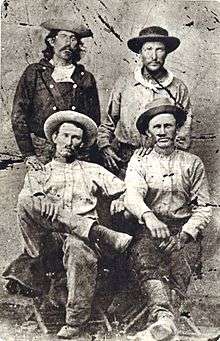
The identity of the first westbound rider to depart St. Joseph has been disputed, but currently most historians have narrowed it down to either Johnny Fry or Billy Richardson.[28][43][44][7] Both Expressmen were hired at St. Joseph for A. E. Lewis' Division which ran from St. Joseph to Seneca, Kansas, a distance of 80 miles (130 km). They covered at an average speed of 12 1⁄2 miles per hour (20 km/h), including all stops.[45] Before the mail pouch was delivered to the first rider on April 3, 1860, time was taken out for ceremonies and several speeches. First, Mayor M. Jeff Thompson gave a brief speech on the significance of the event for St. Joseph. Then William H. Russell and Alexander Majors addressed the gala crowd about how the Pony Express was just a "precursor" to the construction of a transcontinental railroad. At the conclusion of all the speeches, approximately 7:15 p.m., Russell turned the mail pouch over to the first rider. A cannon fired, the large assembled crowd cheered, and the rider dashed to the landing at the foot of Jules Street where the ferry boat Denver, under a full head of steam, alerted by the signal cannon, waited to carry the horse and rider across the Missouri River to Elwood, Kansas Territory.[46][47] On April 9 at 6:45 p.m., the first rider from the east reached Salt Lake City, Utah. Then, on April 12, the mail pouch reached Carson City, Nevada at 2:30 p.m. The riders raced over the Sierra Nevada Mountains, through Placerville, California and on to Sacramento. Around midnight on April 14, 1860, the first mail pouch was delivered via the Pony Express to San Francisco. Bringing with it was a letter of congratulations from President Buchanan to California Governor Downey along with other official government communications, newspapers from New York, Chicago, and St. Louis, along with other important mail to banks and commercial houses in San Francisco. In all, 85 pieces of mail were delivered on this first trip.[48]
James Randall is credited as the first eastbound rider from the San Francisco Alta telegraph office since he was on the steamship Antelope to go to Sacramento.[49] Mail for the Pony Express left San Francisco at 4:00 pm, carried by horse and rider to the waterfront, and then on by steamboat to Sacramento where it was picked up by the Pony Express rider. At 2:45 a.m., William (Sam) Hamilton was the first Pony Express rider to begin the journey from Sacramento. He rode all the way to Sportsman Hall Station where he gave his mochila filled with mail to Warren Upson.[50] A California Registered Historical Landmark plaque at the site reads:
This was the site of Sportsman's Hall, also known as the Twelve-Mile House. The hotel operated in the late 1850's and 1860's by John and James Blair. A stopping place for stages and teams of the Comstock, it became a relay station of the central overland Pony Express. Here, at 7:40 a.m., April 4, 1860, Pony rider William (Sam) Hamilton, riding in from Placerville, handed the Express mail to Warren Upson who, two minutes later, sped on his way eastward.— Plaque at Sportsman Hall
William Cody
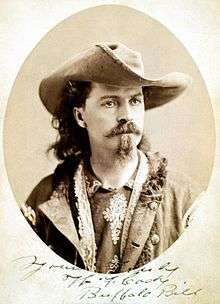
Probably more than any other rider in the Pony Express, William Cody (better known as Buffalo Bill) epitomizes the legend and the folklore, be it fact or fiction, of the Pony Express.[51][52] Numerous stories have been told of young Cody's adventures as a Pony Express rider. At the age of 15 Cody was on his way west to California when he met Pony Express agents along the way and signed on with the company. Cody helped in the construction of several way-stations. Thereafter, he was employed as a rider and was given a short 45-mile (72 km) delivery run from the township of Julesburg which lay to the west. After some months he was transferred to Slade's Division in Wyoming where he made the longest non-stop ride from Red Buttes Station to Rocky Ridge Station and back when he found that his relief rider had been killed. The distance of 322 miles (518 km) over one of the most dangerous sections of the entire trail was completed in 21 hours and 40 minutes, and 21 horses were required to complete this section.[23] Cody was present for many significant chapters in early western history, including the gold rush, the building of the railroads and cattle herding on the Great Plains. A career as a scout for the Army under General Phillip Sheridan following the Civil War earned him his nickname and established his notoriety as a frontiersman.[53][54][55]
Robert Haslam

Robert Haslam (Pony Bob) was among the most brave, resourceful, and best-known riders of the Pony Express. He was born January 1840 in London, England, and came to the United States as a teenager. Haslam was hired by Bolivar Roberts, helped build the stations, and was given the mail run from Friday's Station at Lake Tahoe to Buckland's Station near Fort Churchill, 75 miles (121 km) to the east.
His greatest ride, 120 miles (190 km) in 8 hours and 20 minutes while wounded, was an important contribution to the fastest trip ever made by the Pony Express. The mail carried Lincoln's inaugural address. Indian problems in 1860 led to Pony Bob Haslam's record-breaking ride. He had received the eastbound mail (probably the May 10 mail from San Francisco) at Friday's Station. When he reached Buckland's Station his relief rider was so badly frightened over the Indian threat that he refused to take the mail. Haslam agreed to take the mail all the way to Smith's Creek for a total distance of 190 miles (310 km) without a rest. After a rest of nine hours, he retraced his route with the westbound mail where, at Cold Springs, he found that Indians had raided the place, killing the station keeper and running off all of the stock. On the ride he was shot through the jaw with an Indian arrow, losing three teeth.[56] Finally, he reached Buckland's Station, making the 380-mile (610 km) round trip the longest on record.[23]
Pony Bob continued to work as a rider for Wells Fargo and Company after the Civil War, scouted for the U.S. Army well into his fifties, and later accompanied his good friend Buffalo Bill Cody on a diplomatic mission to negotiate the surrender of Chief Sitting Bull in December 1890. He drifted in and out of public mention but eventually died in Chicago during the winter of 1912 (age 72) in deep poverty after suffering a stroke. Buffalo Bill paid for his friend's headstone at Mount Greewood Cemetery (111 Street and Sacramento) on Chicago's far south side.[57]
Jack Keetley
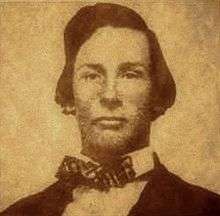
Jack Keetley was hired by A. E. Lewis for his Division at the age of nineteen, and put on the run from Marysville to Big Sandy. He was one of those who rode for the Pony Express during the entire nineteen months of its existence.
Jack Keetley's longest ride, upon which he doubled back for another rider, ended at Seneca where he was taken from the saddle sound asleep. He had ridden 340 miles (550 km) in thirty-one hours without stopping to rest or eat.[58][59] After the Pony Express was disbanded, Keetley went to Salt Lake City where he engaged in mining. He died there on October 12, 1912 where he was also buried.[60]
In 1907, Keetley wrote the following letter (excerpt):
Alex Carlyle was the first man to ride the Pony Express out of St. Joe. He was a nephew of the superintendent of the stage line to Denver, called the "Pike's Peak Express." The superintendent's name was Ben Ficklin. Carlyle was a consumptive, and could not stand the hardships, and retired after about two months trial, and died within about six months after retiring. John Frye was the second rider, and I was the third, and Gus Cliff was the fourth.
I made the longest ride without a stop, only to change horses. It was said to be 300 miles and was done a few minutes inside of twenty-four hours. I do not vouch for the distance being correct, as I only have it from the division superintendent, A.E. Lewis, who said that the distance given was taken by his English roadometer which was attached to the front wheel of his buggy which he used to travel over his division with, and which was from St. Joe to Fort Kearney.[59]
— Jack Keetley
Billy Tate
Billy Tate was a 14-year-old Pony Express rider who rode the express trail in Nevada near Ruby Valley. During the Paiute uprising of 1860 he was chased by a band of Paiute Indians on horseback and was forced to retreat into the hills behind some big rocks where he killed seven of his assailants in a shoot-out before being killed himself. His body was found riddled with arrows but was not scalped, a sign that the Paiutes honored their enemy.[61]
Horses
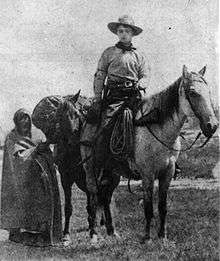
An estimated 400 horses in total were used by the Pony Express to deliver the mail. Horses were selected for swiftness and endurance. On the east end of Pony Express route the horses were usually selected from U.S. Cavalry units. At the west end of the Pony Express route in California, W.W. Finney purchased 100 head of short coupled stock called "California Horses"' while A.B. Miller purchased another 200 native ponies in and around the Great Salt Lake Valley. The horses were ridden quickly between stations, an average distance of 15 miles (24 km), and then were relieved and a fresh horse would be exchanged for the one that just arrived from its strenuous run.
During his route of 80 to 100 miles (130 to 160 km), a Pony Express rider would change horses 8 to 10 times. The horses were ridden at a fast trot, canter or gallop, around 10 to 15 miles per hour (16 to 24 km/h) and at times they were driven to full gallop at speeds up to 25 miles per hour (40 km/h). Horses of the Pony Express were purchased in Missouri, Iowa, California, and some western U.S. territories.
The various types of horse ridden by riders of the Pony Express included Morgans and thoroughbreds which were often used on the eastern end of the trail. Mustangs were often used on the western (more rugged) end of the mail route. [62]
Saddle

In 1844, years before the Pony Express came to St. Joseph, Israel Landis opened a small saddle and harness shop there. His business expanded as the town grew, and when the Pony Express came to town Landis was the ideal candidate to produce saddles for the newly founded Pony Express. Because Pony Express riders rode their horses at a quick pace over a distance of 10 miles (16 km) or more between stations, every consideration was made to reduce the overall weight the horse had to carry. To help reduce this load, special lightweight saddles were designed and crafted. Using less leather and fewer metallic and wood components they fashioned a saddle that was similar in design to the regular stock saddle generally in use in the West at that time.[63]
The mail pouch was a separate component to the saddle that made the Pony Express unique. Standard mail pouches for horses were never employed because of their size and shape, as it was time consuming detaching and attaching it from one saddle to the other, causing undue delay in changing mounts. With many stops to make, the delayed time at each station would accumulate to appreciable proportions. To get around this difficulty, a mochila, or covering of leather, was thrown over the saddle. The saddle horn and cantle projected through holes which were specially cut to size in the mochila. Attached to the broad leather skirt of the mochila were four cantinas, or box-shaped hard leather compartments, where letters were carried on the journey.[63]
Closing
During its brief time in operation, the Pony Express delivered approximately 35,000 letters between St. Joseph, Missouri, and Sacramento, California.[64] Although the Pony Express proved that the central/northern mail route was viable, Russell, Majors and Waddell did not get the contract to deliver mail over the route. The contract was instead awarded to Jeremy Dehut in March 1861, who had taken over the southern Congressionally favored Butterfield Overland Mail Stage Line. The so-called 'Stagecoach King', Ben Holladay, acquired the Russell, Majors and Waddell stations for his stagecoaches.
Shortly after the contract was awarded, the start of the American Civil War caused the stage line to cease operation. From March 1861, the Pony Express ran mail only between Salt Lake City and Sacramento. The Pony Express announced its closure on October 26, 1861, two days after the transcontinental telegraph reached Salt Lake City and connected Omaha, Nebraska, and Sacramento, California. Other telegraph lines connected points along the line and other cities on the east and west coasts.[65]
The Pony Express grossed $90,000 and lost $200,000.[66]
In 1866, after the Civil War was over, Holladay sold the Pony Express assets along with the remnants of the Butterfield Stage to Wells Fargo for $1.5 million.
Commemorations
In 1869 the United States Post Office issued the first U.S. Postage stamp to depict an actual historic event, and the subject that was chosen was the Pony Express. Until then only the faces of George Washington, Benjamin Franklin, Thomas Jefferson and Andrew Jackson were found on the face of U.S. Postage.[67] Sometimes mistaken for an actual stamp used by the Pony Express, the 'Pony Express Stamp' issue was released in 1869 (8 years after the Pony Express service had ended) to honor the men who rode the long and sometimes dangerous journeys and to commemorate the service they provided for the nation. In 1940 and 1960 commemorative stamps were issued for the 80th and 100th anniversaries of the Pony Express respectively.
 Pony Express Rider, Issue of 1869 |
Pony Express 80th Anniversary, Issue of 1940 |
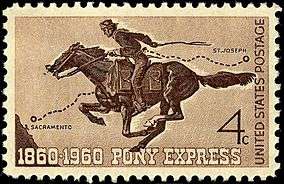 Pony Express 100th anniversary, Issue of 1960 |
National Pony Express Association (NPEA) is a non-profit, volunteer-led historical organization. Its purpose is to preserve the original Pony Express trail and to continue the memory and importance of Pony Express in American history in partnership with the National Park Service, Pony Express Trail Association, and the Oregon-California Trails Association.
April 3, 2010 was the Pony Express' 150th anniversary. Located in St. Joseph, Missouri, the Patee House Museum, which was the Pony Express' headquarters, hosted events celebrating the anniversary.[68]
Historical research
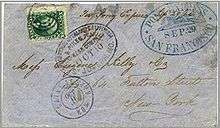
The foundation of accountable Pony Express history rests in the few tangible areas where records, papers, letters and mailings have yielded the most historical evidence. Until the 1950s most of what was known about the short-lived Pony Express was the product of a few accounts, hearsay and folklore, generally true in their overall aspects, but lacking in verification in many areas for those who wanted to explore the history surrounding the founders, the various riders and station keepers or who were interested in stations or Forts along the Pony Express route.
The most complete books on the Pony Express are The Story of the Pony Express and Saddles and Spurs by Raymond & Mary Settle and Roy Bloss. Settle's account is unique as he was the first writer and historical researcher to make use of Pony Express founder William B. Waddell's papers, now in a collection at the Huntington Library in San Marino, California. Mr. Settle wrote in the mid-1950s. Mr. Bloss was a writer for the Pony Express Centennial. While Settle's work was published generally without his annotations and notes, the writer's background here is unique and Settle does have an excellent bibliography. When Settle prepared to publish his well-researched account he had a good volume of footnotes, citations prepared, but the editors chose not to use most of them. Instead, they opted for a less expensive approach to print and publish and released an accurate, but simplified account. Settle was not pleased with this new and sudden development, as he put much time and effort into the annotations. Yet, the account Settle wrote was and is a definitive one and is considered the best account on the history of the Pony Express amongst many historians.[69]
Legacy
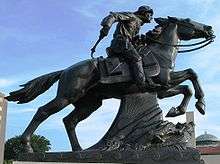
Wells Fargo used the Pony Express logo for its guard and armored car service. The logo continued to be used when other companies took over the security business into the 1990s. From 2001, the Pony Express logo is no longer used for security businesses since the business has been sold.[70]
The United States Postal Service has trademarked "Pony Express" along with "Air Mail".[71]
The Pony Express route has been designated the Pony Express National Historic Trail. Approximately 120 historic sites along the trail may eventually be open to the public, including 50 stations or station ruins.[72]
In popular culture
The continued remembrance and popularity of the Pony Express can be linked to Buffalo Bill Cody, his autobiographies, and his Wild West Show. The first book dedicated solely to the Pony Express was not published until 1900.[73] However, in his first autobiography, published in 1879, Cody claims to have been an Express rider.[74][75] While this claim has recently come under dispute,[73] his show became the "primary keeper of the pony legend" when it premiered as a scene in the Wild West Show.[73]
Film
- The Pony Express (1925)[76]
- Frontier Pony Express (1939)[77]
- Pony Post (1940)[78]
- Plainsman and the Lady (1946)[79]
- Pony Express (1953)[80]
- Last of the Pony Riders (1953)[81]
- The Pony Express Rider (1976)[82]
- Days of the Pony Express (2008)
- Spirit of the Pony Express (2012)[83]
Television
- The Range Rider (1951–1953) season 1 episode "The Last of the Pony Express"[84]
- Pony Express (1959–1960) [85]
- Bonanza (1959–1973) season 7 two-part episode "Ride the Wind"[86][87]
- The Young Riders (1989–1992)
- Into the West (2005)
See also
- Joseph Alfred Slade
- Ortoo
- Pony Express Museum
- Pony Express mochila
- Postage stamps and postal history of the United States
- Royal Road
- The Postman
Notes
References
- ↑ Bradley (1913), p. 21.
- ↑ Bradley (1913), pp. 25–29.
- ↑ Bradley (1913), p. 9.
- ↑ Peters 1996, pp. 147–148.
- ↑ Settle & Settle (1972), pp. 4–5.
- ↑ Chapman (1932), p. 76.
- 1 2 3 "Pony Express National Museum". City of St Joseph. Retrieved December 10, 2012.
- ↑ Settle & Settle (1955), p. 42.
- ↑ Bradley (1913), p. 27.
- ↑ Settle & Settle (1972), p. 52.
- ↑ Burton, Richard (1862). The City of the Saints. New York: Harper & Brothers.
- ↑ Bradley (1913), p. 52.
- ↑ "United States Patent and Trademark Office S/N 75218057 et al".
- ↑ "Freight Link Russia". Retrieved December 10, 2012.
- ↑ "Title unknown". National Park Service.
- ↑ "Buffalo Bill Days History". Sheridan Heritage Center. Retrieved December 10, 2012.
- ↑ Bradley (1913), p. 25.
- ↑ Pope, Nancy (April–June 1992). "The Story Of The Pony Express". EnRoute. National Postal Museum. 1 (2). Retrieved December 10, 2012.
- ↑ National Park Service (n.d.). National Scenic and Historic Trails (PDF) (Map). Scale not given. National Park Service. Retrieved December 10, 2012.
- ↑ Peters 1996, pp. 153.
- ↑ Settle & Settle (1972), p. 113.
- ↑ Godfrey (1994).
- 1 2 3 4 Settle & Settle (1972), p. 162.
- 1 2 Frajola, Kramer & Walske (2005).
- ↑ Scotts Specialized catalogue of U.S. Postage Stamps / Envelopes
- ↑ "Hannibal & Joseph Railroad". XP Home Station. Retrieved December 10, 2012.
- ↑ Godfrey (1994), Chap 2.
- 1 2 Root & Hickman (1946), Note 358.
- ↑ "Westbound". XP Home Station. Retrieved December 10, 2012.
- ↑ Peters 1996, pp. 160–162.
- ↑ Settle & Settle (1955), p. 61.
- ↑ Federal Reserve Bank of Minneapolis Community Development Project. "Consumer Price Index (estimate) 1800–". Federal Reserve Bank of Minneapolis. Retrieved October 21, 2016.
- ↑ "Richard Frajola, Philatelist (Postmarks enhanced)". Retrieved December 10, 2012.
- ↑ "Pony Express: Romance versus Reality". National Postal Museum. Retrieved December 10, 2012.
- 1 2 Scotts Specialized Catalogue of United States Stamps
- ↑ Angel (1881), p. 151.
- ↑ Michno (2007), p. 89-90.
- ↑ Frajola, Kramer & Walske (2005), p. 18.
- ↑ Thompson (2005).
- ↑ Reinfeld (1973), p. 49.
- ↑ Settle & Settle (1972), pp. 73–74.
- ↑ Settle & Settle (1972), pp. 74–76.
- ↑ "National Historic Trail: Pony Express Stables". National Park Service.
- ↑ Godfrey (1994), Chap 2 p. 5.
- ↑ Bradley, Glen (1913). The Story of the Pony Express. Retrieved December 10, 2012.
- ↑ Settle & Settle (1955), p. 58.
- ↑ Bradley (1913), p. 31.
- ↑ Bradley (1913), pp. 46–47.
- ↑ Jean Williams (2002). The Pony Express. Compass Point Books. p. 27. ISBN 978-0756503017.
- ↑ Godfrey (1994), Chap 8 p. 3.
- ↑ Bradley (1913), p. 127.
- ↑ Settle & Settle (1972), p. 83.
- ↑ Buffalo Bill's Wild West, R.L. Wilson
- ↑ Settle & Settle (1972), p. 84.
- ↑ Johns, Joshua. "Pony Express History". University of Virginia. Retrieved December 10, 2012.
- ↑ "Wyoming Tales and Trails". Retrieved December 10, 2012.
- ↑ Corbett (2003), pp. 198–199.
- ↑ Bradley (1913), p. 109.
- 1 2 Visscher, William Lightfoot (1980). Pony Express, A Thrilling and Truthful History. Vistabooks.
- ↑ Settle & Settle (1972), p. 100.
- ↑ McNesse (2009), p. 105.
- ↑ Stong, Phil (1939). Horses and Americans. New York: Frederick A. Stokes. A history of horses in America from the arrival of the Arab Plains horses sometime around 1600, through the colonial period, taking in the Revolutionary War, Western migration and Cowboys, the Pony Express, the Civil War, the U.S. Cavalry, thoroughbred racing, and so on through the early 1930s.
- 1 2 Chapman (1932).
- ↑ "Replica of a Pony Express mochila". Smithsonian National Postal Museum. Retrieved July 21, 2014.
- ↑ "The First Transcontinental Telegraph System Was Completed October 24, 1861". AmericasLibrary.gov: America's Story from America's Library. Library of Congress. Retrieved September 14, 2012.
- ↑ "Financial Problems". XP Home Station. Retrieved December 10, 2012.
- ↑ Scotts United States Stamp Catalogue.
- ↑ "Pony Express Sesquicentennial Banquet" (PDF). St. Joseph, Missouri Travel and Tourism. Retrieved February 9, 2010.
- ↑ "Russell, William Hepburn". American National Biography. Oxford University Press. Retrieved December 10, 2012.
- ↑ "Wells Fargo Reacquires Name Rights from Borg-Warner" (Press release). Wells Fargo. May 4, 1999. Retrieved December 11, 2012.
- ↑ The United States Postal Service: An American History. Government Relations. United States Postal Service. 2007. p. 85.
- ↑ "Pony Express National Historic Trail: History and Culture". National Park Service. Retrieved August 31, 2013.
- 1 2 3 Warren, Louis S. (2005). Buffalo Bill's America: William Cody and the Wild West Show (1st ed.). Knopf. ISBN 978-0-375-41216-5.
- ↑ Cody, William F. The Life of Honorable William F. Cody. Retrieved December 10, 2012.
- ↑ Cody, William F. The Life and Adventures of "Buffalo Bill" Colonel William F. Cody. Retrieved December 10, 2012.
- ↑ The Pony Express at the Internet Movie Database
- ↑ Frontier Pony Express at the Internet Movie Database
- ↑ Pony Post at the Internet Movie Database
- ↑ Plainsman and the Lady at the Internet Movie Database
- ↑ Pony Express at the Internet Movie Database
- ↑ Last of the Pony Riders at the Internet Movie Database
- ↑ The Pony Express Rider at the Internet Movie Database
- ↑ Spirit of the Pony Express at the Internet Movie Database
- ↑ The Range Rider at the Internet Movie Database
- ↑ Pony Express at the Internet Movie Database
- ↑ Bonanza "Ride the Wind" pt. 1 at the Internet Movie Database
- ↑ Bonanza "Ride the Wind" pt. 2 at the Internet Movie Database
Bibliography
- Angel, Myron, ed. (1881). History of Nevada. Oakland, California: Thompson and West. Retrieved September 14, 2012.
- Beasley, Delilah Leontium (1919). The Negro trail blazers of California. Times Mirror Printing and Binding House.
- Bradley, Glenn Danford (1913). The story of the Pony Express. A. C. McClurg & Co. Retrieved June 15, 2014.
- Chapman, Arthur (1932). The pony express: the record of a romantic adventure in business. G. P. Putnam's Sons.
- Century Magazine. New York. XXXIV. 1898. Missing or empty
|title=(help) - Cody, William F. & Visscher, William Lightfoot (1917). Life and Adventures of 'Buffalo Bill' Colonel William F. Cody. Stanton and Van Vliet.
- Corbett, Christopher (2003). Orphans Preferred: The Twisted Truth and Lasting Legend of the Pony Express. New York: Broadway Books. ISBN 9780767906920.
- Egan, Ferol (1972). The Pony Express: The Record of a Romantic Adventure in Business. University of Nevada Press. p. 316. ISBN 0-87417-097-4.
- Frajola, Richard C.; Kramer, George J. & Walske, Steven C. (2005). The Pony Express, A Postal History (PDF). The Philatelic Foundation. ISBN 0-911989-03-X.
- Godfrey, Anthony (1994). "Pony Express National Historic Trail Historic Resource Study". National Park Service. Retrieved February 20, 2012.
- Majors, Alexander & Cody, William (1873). The Pony Express: Bringing Mail to the American West. The Western Miner and Financier.
- McNesse, Tim (2009). The Pony Express: Bringing Mail to the American West. Infobase Publishing. p. 138. ISBN 9781438119847.
- Michno, Gregory (2007). The Deadliest Indian War in the West: The Snake Conflict, 1864-1868. Caxton Press. p. 157. ISBN 978-0-87004-460-1. Retrieved September 15, 2012.
- Peters, Arthur K. (1996). Seven Trails West. Abbeville Press. ISBN 1-55859-782-4.
- Reinfeld, Fred (1973). Pony Express. Macmillan / Bison Books. ISBN 9780803257863.
- Root, George A. & Hickman, Russell K. (February 1946). "Part IV-The Platte Route-Concluded. The Pony Express and Pacific Telegraph". Kansas Historical Quarterly. 14 (1): 36–92. Retrieved December 10, 2012.
- Settle, Raymond & Settle, Mary (1949). Empire on Wheels. Stanford University Press. p. 153.
- Settle, Raymond & Settle, Mary (1955). Saddles and Spurs: The Pony Express Saga. Stackpole.
- Settle, Raymond & Settle, Mary (1972). Saddles and Spurs: The Pony Express Saga. Bison Books. ISBN 9780803257658. Retrieved December 10, 2012.
- Thompson, Don (March 20, 2005). "Historian finds Pony Express ad". U-T San Diego. Associated Press. Retrieved September 16, 2012.
Further reading
- Fike, Richard E. & Headley, Joh W. (1979). The Pony Express Stations of Utah in Historical Perspective. Washington, D.C.: Bureau of Land Management, Utah.
- Luff, John Nicholas (1902). The Postage Stamps of the United States. Scott Stamp & Coin Company.
- Visscher, William Lightfoot (1908). A Thrilling and Truthful History of the Pony Express: Or, Blazing the Westward Way. Rand McNally.
External links
- Spirit of the Pony Express (Documentary)
- Pony Express National Historic Trail (National Park Service)
- "Inventory of the Waddell F. Smith Papers,1939-1976". Online Archive of California.
- Hartnagle, Ernie & Hartnagle, Elaine. "The Correct Identity of Billy Richardson, the Pony Express Rider".
- "Hollenberg Pony Express Station". kansastravel.org.
- Pony Express home station
- The True Story of Billy Tate Pony Express Rider Who died at 14-years-old